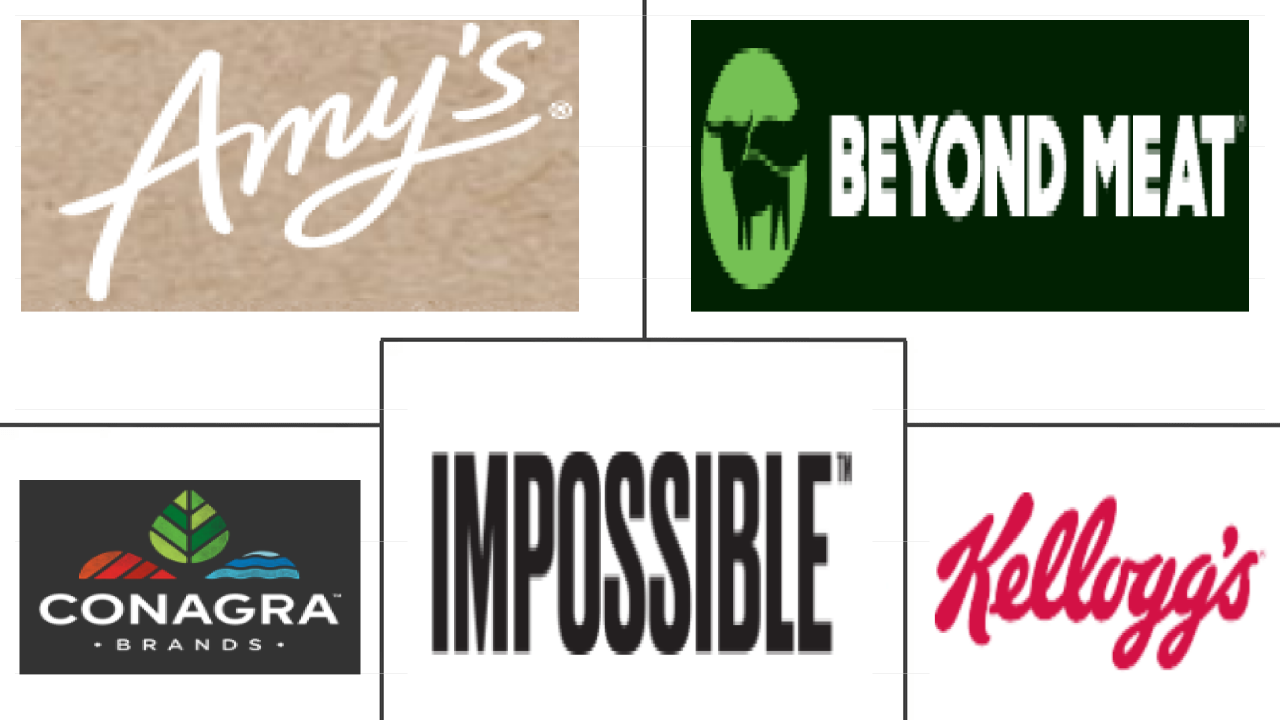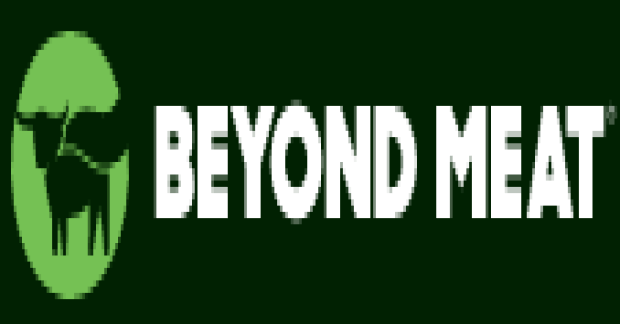Market Size of meat substitutes Industry
|
|
Study Period | 2017 - 2029 |
|
|
Market Size (2024) | USD 9.37 Billion |
|
|
Market Size (2029) | USD 15.99 Billion |
|
|
Largest Share by Type | Textured Vegetable Protein |
|
|
CAGR (2024 - 2029) | 11.28 % |
|
|
Largest Share by Region | Europe |
Major Players |
||

|
||
|
*Disclaimer: Major Players sorted in no particular order |
Meat Substitutes Market Analysis
The Meat Substitutes Market size is estimated at 9.37 billion USD in 2024, and is expected to reach 15.99 billion USD by 2029, growing at a CAGR of 11.28% during the forecast period (2024-2029).
9.37 Billion
Market Size in 2024 (USD)
15.99 Billion
Market Size in 2029 (USD)
7.55 %
CAGR (2017-2023)
11.28 %
CAGR (2024-2029)
Largest Segment by Type
59.68 %
value share, Textured Vegetable Protein, 2023
Typically obtained in soy, wheat, and peas among other sources, TVP has gained popularity among food manufacturers as a functional and nutritious meat substitute.
Largest Segment by Region
33.86 %
value share, Europe, 2023
The popularity of protein-enriched plant-based diets and regional government promotions encouraging healthy living has led to Europeans decreasing their meat intake.
Fastest-growing Segment by Type
12.33 %
Projected CAGR, Tempeh, 2024-2029
Tempeh is increasing in demand in regions like Europe and Asia-Pacific due to its good meat substituting properties, ease to manufacture, and culinary versatility.
Fastest-growing Segment by Region
12.35 %
Projected CAGR, Asia-Pacific, 2024-2029
Consumption of meat substitutes is gaining traction in major countries like China, India, and Australia where people are looking for an adequate plant-based protein source.
Leading Market Player
4.48 %
market share, Beyond Meat Inc., 2022

The company's high-quality TVP products including pea and soy protein, with a broader protein range of 70-90% for broader application, make it the market leader.
Sustainability and environmental concerns are majorly driving the growth of a vegan society
- During 2019-2022, the sales value of meat substitutes observed a positive growth, registering a CAGR of 25.19%, owing to the increasing consciousness toward accommodating alternate protein sources to combat the adverse health troubles associated with animal protein, like cardiovascular diseases and diabetes. The increasing consciousness among people to choose an eco-friendly lifestyle is also pushing the demand for meat substitutes. While most meat products derived from livestock have a limited shelf life, meat alternatives derived from soybeans and other plant-based sources can remain fresh for an entire year, thus increasing their preference.
- TVP is the most consumed meat substitute worldwide. The sales value of TVP increased, registering a CAGR of 6.54% from 2017 to 2022. The emergence of TVP from sources like soy, wheat, and peas demonstrates a change in consumer demand from animal protein to plant protein with similar nutritional characteristics. Some major TVP manufacturers are ADM, Cargill, Ingredion Incorporated, and Kerry Group PLC. Key players are partnering with meat alternative manufacturers, like Beyond Meat, Impossible Foods, Eat Just, and Quorn, to increase their market penetration.
- Tempeh is projected to be the fastest-growing meat substitute, recording a CAGR of 12.04% by value during the forecast period. The high level of protein in tempeh makes it a suitable alternative to animal-derived meat. Among women, a soy-rich diet is scientifically proven to pose a lower risk of breast cancer, which currently affects approximately 2.3 million women worldwide. Tempeh is often fortified with vitamin B12, which is not bioavailable in plant-based foods, making it one of the ideal meat substitutes accommodated in one's diet.
Rising health concerns and the launch of a wide range of meat substitutes boost sales
- Of all regions, Asia-Pacific is expected to be the fastest-growing region, with a projected CAGR value of 12.38% during the forecast period (2023-2029). This is due to a large vegetarian and flexitarian population, accounting for around 4.98 million vegetarians worldwide. Of these, 3.8 million were from India, a country that mainly prefers to consume vegetarian food. Therefore, such consumers look for meat-like texture products as a healthy alternative to meat. Inappropriate use of antibiotics in food animals contributes to antimicrobial resistance. Thus, meat substitutes can decrease the risk of global public health issues such as antibiotic resistance and zoonotic threats.
- Europe dominated the market with a 5% more market share than North America as of 2022. Rising government promotions for meat substitutes, like the committee on beating cancer, BECA, which aims to reduce meat consumption due to the high mortality rate of cancer (1.9 million deaths) and promotes plant-based meats as an alternative to meat consumption, are driving the European meat substitute market.
- However, the Middle East is estimated to be a high-growing region that consumes meat substitutes, with a projected CAGR of 11.79% during the forecast period (2023-2029). With the increasing expat population in countries like the United Arab Emirates (8.34 million) and Saudi Arabia (2.9 million), several new start-ups, like Vbites, Fazenda Futuro, and KBW ventures, are attracting customers toward meat substitutes. However, awareness about global warming and various health concerns of continuous meat consumption are also some reasons for the rising consumption of meat substitutes.
Meat Substitutes Industry Segmentation
Tempeh, Textured Vegetable Protein, Tofu are covered as segments by Type. Off-Trade, On-Trade are covered as segments by Distribution Channel. Africa, Asia-Pacific, Europe, Middle East, North America, South America are covered as segments by Region.
- During 2019-2022, the sales value of meat substitutes observed a positive growth, registering a CAGR of 25.19%, owing to the increasing consciousness toward accommodating alternate protein sources to combat the adverse health troubles associated with animal protein, like cardiovascular diseases and diabetes. The increasing consciousness among people to choose an eco-friendly lifestyle is also pushing the demand for meat substitutes. While most meat products derived from livestock have a limited shelf life, meat alternatives derived from soybeans and other plant-based sources can remain fresh for an entire year, thus increasing their preference.
- TVP is the most consumed meat substitute worldwide. The sales value of TVP increased, registering a CAGR of 6.54% from 2017 to 2022. The emergence of TVP from sources like soy, wheat, and peas demonstrates a change in consumer demand from animal protein to plant protein with similar nutritional characteristics. Some major TVP manufacturers are ADM, Cargill, Ingredion Incorporated, and Kerry Group PLC. Key players are partnering with meat alternative manufacturers, like Beyond Meat, Impossible Foods, Eat Just, and Quorn, to increase their market penetration.
- Tempeh is projected to be the fastest-growing meat substitute, recording a CAGR of 12.04% by value during the forecast period. The high level of protein in tempeh makes it a suitable alternative to animal-derived meat. Among women, a soy-rich diet is scientifically proven to pose a lower risk of breast cancer, which currently affects approximately 2.3 million women worldwide. Tempeh is often fortified with vitamin B12, which is not bioavailable in plant-based foods, making it one of the ideal meat substitutes accommodated in one's diet.
| Type | |
| Tempeh | |
| Textured Vegetable Protein | |
| Tofu | |
| Other Meat Substitutes |
| Distribution Channel | ||||||
| ||||||
| On-Trade |
| Region | ||||||||||||||
| ||||||||||||||
| ||||||||||||||
| ||||||||||||||
| ||||||||||||||
| ||||||||||||||
|
Meat Substitutes Market Size Summary
The Meat Substitutes Market is experiencing significant growth, driven by increasing consumer awareness of health and environmental benefits associated with plant-based proteins. The shift from animal to plant-based proteins is largely due to concerns over health issues linked to animal protein consumption, such as cardiovascular diseases and diabetes, as well as a growing preference for eco-friendly lifestyles. The market is characterized by a diverse range of products, with Textured Vegetable Protein (TVP) being the most consumed globally. The demand for TVP, derived from soy, wheat, and peas, reflects a broader trend towards plant proteins that offer similar nutritional benefits to animal proteins. Key industry players are actively partnering with companies like Beyond Meat and Impossible Foods to enhance their market presence and expand their product offerings.
Regionally, Asia-Pacific is anticipated to be the fastest-growing market, fueled by a large vegetarian and flexitarian population seeking meat-like alternatives. Europe currently leads the market, supported by government initiatives promoting plant-based diets to combat health issues like cancer. The Middle East is also emerging as a high-growth region, driven by an increasing expatriate population and rising awareness of health and environmental concerns. The market is fragmented, with major companies like Amy's Kitchen, Beyond Meat, and Impossible Foods holding a modest share. Recent strategic moves, such as acquisitions and product expansions, indicate a dynamic market landscape, with ongoing efforts to meet the rising demand for meat substitutes globally.
Meat Substitutes Market Size - Table of Contents
-
1. MARKET SEGMENTATION (includes market size in Value in USD, Forecasts up to 2029 and analysis of growth prospects)
-
1.1 Type
-
1.1.1 Tempeh
-
1.1.2 Textured Vegetable Protein
-
1.1.3 Tofu
-
1.1.4 Other Meat Substitutes
-
-
1.2 Distribution Channel
-
1.2.1 Off-Trade
-
1.2.1.1 Convenience Stores
-
1.2.1.2 Online Channel
-
1.2.1.3 Supermarkets and Hypermarkets
-
1.2.1.4 Others
-
-
1.2.2 On-Trade
-
-
1.3 Region
-
1.3.1 Africa
-
1.3.1.1 By Type
-
1.3.1.2 By Distribution Channel
-
1.3.1.3 By Country
-
1.3.1.3.1 Egypt
-
1.3.1.3.2 Nigeria
-
1.3.1.3.3 South Africa
-
1.3.1.3.4 Rest of Africa
-
-
-
1.3.2 Asia-Pacific
-
1.3.2.1 By Type
-
1.3.2.2 By Distribution Channel
-
1.3.2.3 By Country
-
1.3.2.3.1 Australia
-
1.3.2.3.2 China
-
1.3.2.3.3 India
-
1.3.2.3.4 Indonesia
-
1.3.2.3.5 Japan
-
1.3.2.3.6 Malaysia
-
1.3.2.3.7 South Korea
-
1.3.2.3.8 Rest of Asia-Pacific
-
-
-
1.3.3 Europe
-
1.3.3.1 By Type
-
1.3.3.2 By Distribution Channel
-
1.3.3.3 By Country
-
1.3.3.3.1 France
-
1.3.3.3.2 Germany
-
1.3.3.3.3 Italy
-
1.3.3.3.4 Netherlands
-
1.3.3.3.5 Russia
-
1.3.3.3.6 Spain
-
1.3.3.3.7 United Kingdom
-
1.3.3.3.8 Rest of Europe
-
-
-
1.3.4 Middle East
-
1.3.4.1 By Type
-
1.3.4.2 By Distribution Channel
-
1.3.4.3 By Country
-
1.3.4.3.1 Bahrain
-
1.3.4.3.2 Kuwait
-
1.3.4.3.3 Oman
-
1.3.4.3.4 Qatar
-
1.3.4.3.5 Saudi Arabia
-
1.3.4.3.6 United Arab Emirates
-
1.3.4.3.7 Rest of Middle East
-
-
-
1.3.5 North America
-
1.3.5.1 By Type
-
1.3.5.2 By Distribution Channel
-
1.3.5.3 By Country
-
1.3.5.3.1 Canada
-
1.3.5.3.2 Mexico
-
1.3.5.3.3 United States
-
1.3.5.3.4 Rest of North America
-
-
-
1.3.6 South America
-
1.3.6.1 By Type
-
1.3.6.2 By Distribution Channel
-
1.3.6.3 By Country
-
1.3.6.3.1 Argentina
-
1.3.6.3.2 Brazil
-
1.3.6.3.3 Rest of South America
-
-
-
-
Meat Substitutes Market Size FAQs
How big is the Global Meat Substitutes Market?
The Global Meat Substitutes Market size is expected to reach USD 9.37 billion in 2024 and grow at a CAGR of 11.28% to reach USD 15.99 billion by 2029.
What is the current Global Meat Substitutes Market size?
In 2024, the Global Meat Substitutes Market size is expected to reach USD 9.37 billion.

